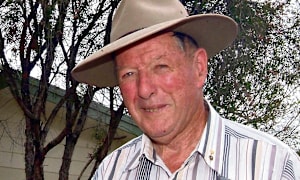
The ‘Cane Toad Challenge’ gives the pests a taste of their own medicine, using their toxins to kill their tadpoles.
Fifteen years of research led Professor Rob Capon to develop the method as a way to eradicate the long term pest.
The warty looking amphibians pose a significant threat to the environment. Professor Capon said many locals of affected areas set out on cane toad bounty hunts armed with golf clubs and baseball bats.
“Cane toads are a problem because they’re toxic, and they have a poison which they use to defend themselves against predators,” he said.
“When they come into an environment like South East Queensland where they are not native, the native predators take on the toads, but they have no immunity to the poison, so they die.
“Australia has been grappling with that problem [of eradication] for 70 to 80 years and the best we’d come up with was Toad Busting.
“So, groups of people would go out and pick up adult toads, usually in the evening or night with a light when they’re easier to find.
“They pick up the adult toads, put them in a bag and dispose of them humanely.”
Professor Capon said the problem with this method was not only was it time consuming but capturing the toads when they were adults meant they’d probably already created hundreds more cane toads in the area.
“The problem is that you’re getting them at a stage when they’ve probably already bred,” he said.
“The next generation simply comes through and replaces them. It’s a never ending story as you’re constantly picking up toads.”
The release of one hundred adult cane toads in Australia just 80 years ago has led to hundreds of millions of the invaders now occupying Australia.
Professor Capon discovered cane toad tadpoles were drawn to a chemical attractant released by toad eggs.
By isolating and identifying the chemical, he and his team developed tadpole attractant baits that he called BufoTabs.
“The strategy is to supplement the Toad Busting while simultaneously trying to take out the tadpoles,” he said.
“The tadpoles are actually easier to find in one respect because the toads are all over the place, they’re in gardens and bushes and hiding.
“But the tadpoles are only around in the breeding season, you can predict when by the weather, they’re in water bodies and they’re close to the edge of the water bodies.”
The pheromonal trap only attracts cane toad tadpoles.
“It’s a way to take out millions of cane toad tadpoles with minimal impact on the environment,” Professor Capon said.
But the method only works if people can use the technique, Professor Capon said after making the discovery and patenting it a decade ago, but it was a long road before he was able to roll out the BufoTabs.
“It took us a long time to find a commercial partner. Only in the next month or so will we be signing off on the commercial agreement,” he said.
Desperate to not waste time, Professor Capon created the Cane Toad Challenge, allowing the baits to be distributed to farmers, councils, community groups and residents all over Queensland and New South Wales.
“A few years ago, out of frustration as much as anything, I launched the Cane Toad Challenge as a citizens science initiative,” Professor Capon said.
“The goal was to try and raise the philanthropic funds we would need to make the baits and give them out for free.
“For the last few years we’ve been giving out thousands and thousands of baits to over one hundred affiliates.”
One of those affiliates is the Scenic Rim Council.
It has been involved in the challenge for about 18 months.
“The program presented an opportunity for Council to better support the community in pest management and to access innovative science that uses the cane toads own toxicity against it,” said a Council spokesman.
However, Council is yet to use the Bufotabs.
“Council planned to deploy them as part of its Environmental Education Program last year, but this was delayed due to Covid-19 restrictions,” the spokesman said.
“Council is working with a non-for-profit organisation that is developing a 3D printed trap to assist in the deployment of the Bufotabs. Council officers are on track to offer Bufotabs as a service through Council's Land for Wildlife program in the 2021 to 2022 financial year.”
Professor Capon said he and his team are hoping a Gold Coast based company will take up the licence for the BufoTab.
“Hopefully in the next few weeks they will take the responsibility for commercialising or delivering the technology to the public and put it on a sustainable commercial footing going forward.”





